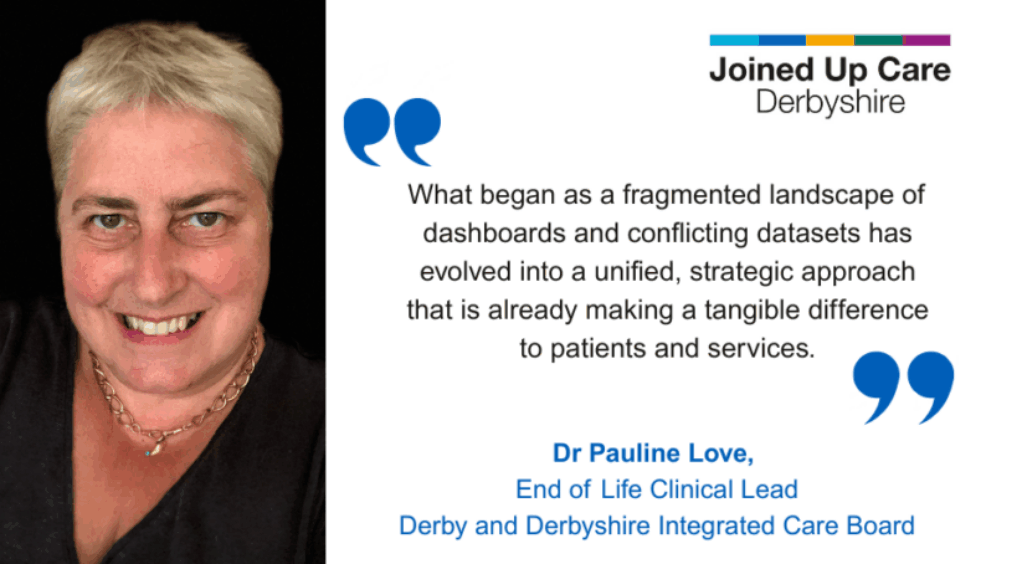Blog: How Joined-Up Data is Transforming End-of-Life Care in Derby and Derbyshire
By Dr Pauline Love, End Of Life Clinical Lead Derby & Derbyshire ICB
In the past year, Derbyshire has embarked on a transformative journey to improve Palliative and end-of-life care (PEoLC) by harnessing the power of joined-up data using a population health management approach.
What began as a fragmented landscape of dashboards and conflicting datasets has evolved into a unified, strategic approach that is already making a tangible difference to patients and services.
Previously, we were relying on multiple dashboards – each offering a snapshot from different sources. One data set might suggest we were doing well, while another painted a less optimistic picture. We wanted to be confident that resources were being directed to the right services and areas to meet patients’ needs effectively. We needed a clear, unified, and accurate view of the data to support informed decision making.
That’s when the journey began: Uzma Rani Palliative and End of Life Care Transformation Lead, from the end of life care team, pulled together data from public health, primary care, NHSE Model Health, the NHSE PEoLC Dashboard and NACEL. Whilst a PHM solution in Derby and Derbyshire ICB was not readily available, the team began by developing simple spreadsheets that consolidated key datasets from multiple platforms, providing a clear, high-level overview.
Pulling together the right data was time-consuming, but ultimately successful. As the data matured, it revealed patterns that would otherwise have remained hidden. The datasets have continued to evolve over time and through work with NHS England within the Federated Data Platform, they will ultimately evolve again. Eventually, the Federated Data Platform will become our PHM solution and allow us to use consistent datasets across ICBs. This will improve data quality and make it easier to share benefits system-wide.
By sharing this consolidated view of the data at the PEoLC Capacity and Demand Modelling meetings, we were able to work with our system partners to ask the right questions: What does this data really tell us about our population’s needs?
We examined demographics, single households, care home residency, hospital admission rates, out of hours service usage and deprivation levels to name a few. For example, we looked at how many people die each year, what they die of, which services they access and what the service capacity looks like across Derby and Derbyshire. This revealed areas of high need, allowing us to target support more effectively.
One of the most impactful outcomes was informing the Marie Curie project. This project will see Marie Curie nurses working closely with GP practices across Derby and Derbyshire equipping local teams with the skills and knowledge to more effectively support people with palliative and end of life care needs.
As part of this, we have been working to understand how early identification in GP practices, access to specialist PEoLC services, and hospital discharge processes are linked to patient outcomes.
Initially, it was unclear where the Marie Curie resource should be placed for greatest impact. But, when we layered several indicators together, we saw a clearer need in the north of the county. As a result, five PCNs across north Derbyshire will be receiving support from the project – something that wouldn’t have happened without our Population Health Management approach.
We also broke down data by GP practices, looked at in-hours vs out-of-hours activity, and engaged with Team Up leads to understand local efforts. Interestingly, we found that areas with a GP who had a special interest in PEoLC had lower admission rates, potentially highlighting the importance of clinical leadership in managing patients better.
This data-driven insight led to several service changes:
- Our system PEoLC facilitators have been focused on delivering education, and feedback highlighted that much of this support was reaching nursing homes more than primary care. The service specification was reviewed and updated to include more GP education with clear KPIs for measuring outcomes.
- We now run quarterly education and training events, both online and in person, for system partners. These cover a wide range of topics, including early identification, Digital ReSPECT plans, and symptom management.
- We identified practices not attending support sessions and provided them with tailored data and offers of bespoke training—extending this to TU teams, community health teams, and soon, specialist providers such CHC.
- By pinpointing areas with low activity but high costs, we were able to improve efficiency by redirecting resources to services under the greatest pressure to better meet patient needs. The community palliative care nursing team, which had been facing workforce challenges, was strengthened using existing resources. This has reduced waiting lists and allowed nurses to spend more time with patients, improving the quality of care.
- Our system partners delivering PEoLC Roaming Services used the data to adjust their operating hours, ensuring provision is better aligned with patient demand.
Previously, updating the PEoLC dashboard was a manual quarterly task. By moving the process into Power BI, updates now flow automatically, saving time and allowing our team to focus on action rather than admin. With a stronger emphasis on PHM analysis and easier access to the right information, we are now better placed to make a real difference for the population we serve.
Ultimately, this joined-up approach has led to a decrease in admissions and more targeted, effective care for PEoLC patients. It’s a testament to what’s possible when we stop looking at isolated snapshots and start seeing the whole picture.
A range of people contributed to this work including the ICB Partnerships team, the Palliative & End of Life Care team, the Business Intelligence team, members of the PEoLC Capacity and Demand Modelling group and Derby City and Derbyshire County Public Health Analysts.

